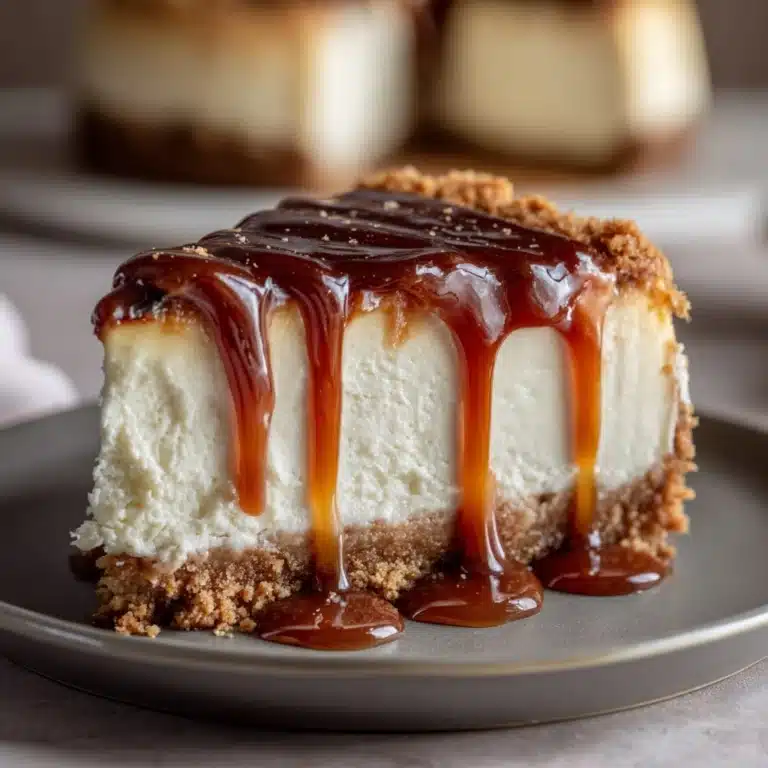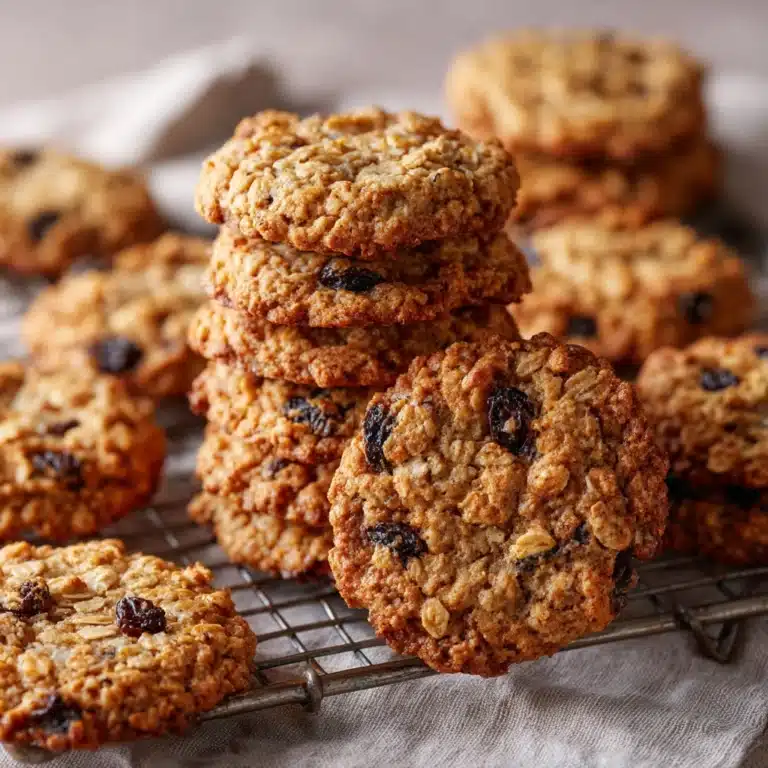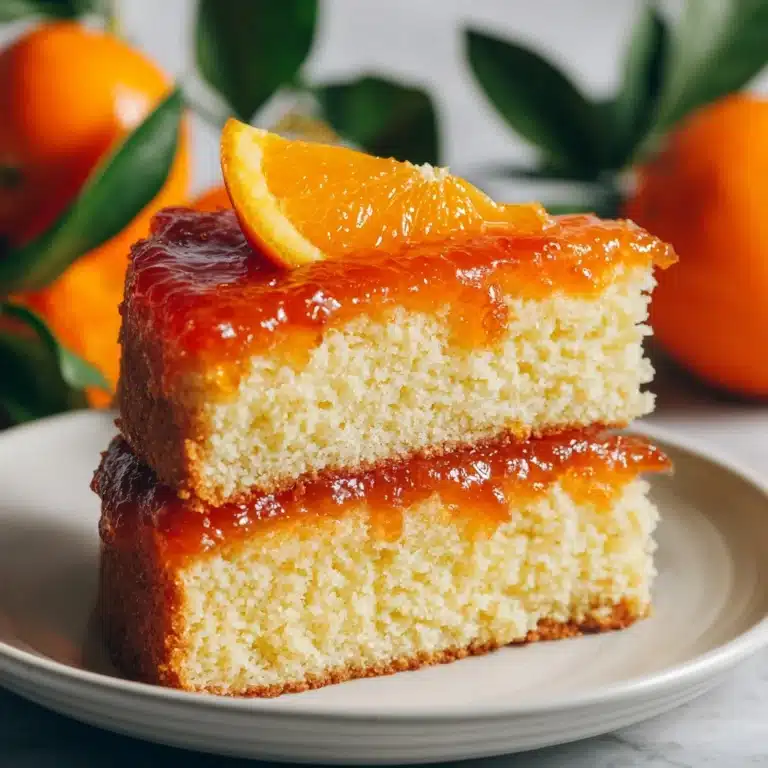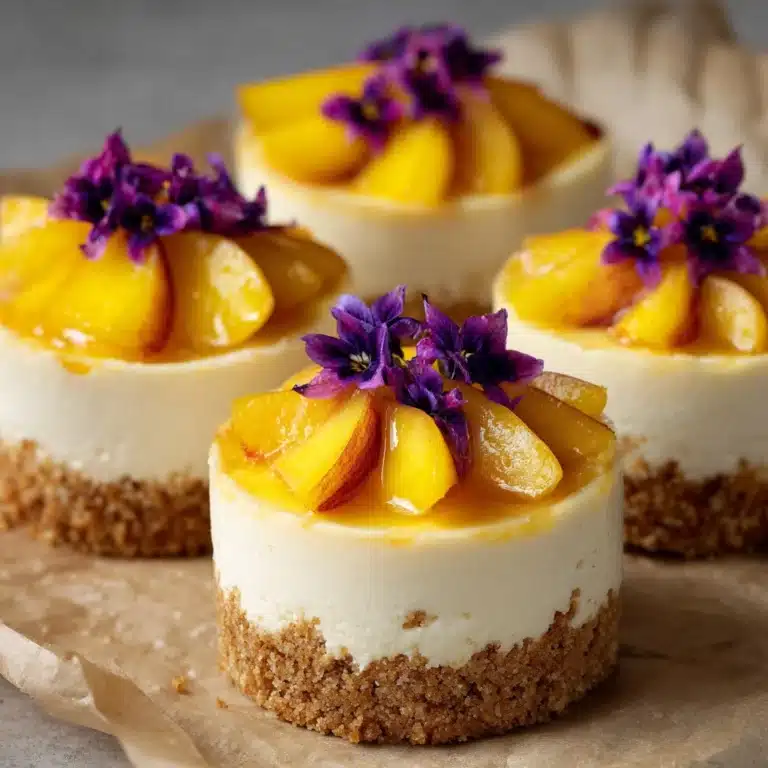Mango Sticky Rice Recipe
If there’s one dessert everyone seems to adore after a Thai meal, it’s Mango Sticky Rice. This vibrant treat captures everything I love about summer: juicy, sun-ripened mangoes, creamy coconut, and perfectly chewy rice. Each bite tastes like a tropical vacation, with sweet, salty, and fragrant notes that make it both irresistible and unforgettable. Whether you’re introducing friends to Thai cuisine Dessert.

Ingredients You’ll Need
What makes Mango Sticky Rice such a delight is how a handful of simple, honest ingredients transform into something magical. Each item is carefully chosen for its role in the flavor and texture, so don’t skip or substitute these—freshness and authenticity really shine here!
- Glutinous (sticky) rice: Not just any rice, this unique variety delivers the signature chewy texture you can’t get from standard white rice.
- Water: Pure and plain, just enough to cook the rice to perfection without turning it mushy.
- Canned coconut milk (full fat): The heart of the creamy sauce; opt for full-fat to get that rich, silky finish.
- Granulated sugar: Just the right amount to sweeten but not overpower, making the mango flavors pop.
- Salt: A dash balances the sweetness and intensifies the coconut’s natural flavor.
- Ripe mangoes, peeled and sliced: Choose mangoes that are fragrant, soft but not mushy—the kind you’d be tempted to eat straight out of hand.
- Toasted sesame seeds or mung beans (optional for garnish): These add a lovely crunch and a hint of nuttiness that plays off the creamy rice and silky mango.
How to Make Mango Sticky Rice
Step 1: Rinse and Soak the Rice
Start by giving your glutinous rice a gentle rinse several times, swirling it around until the water is mostly clear. This removes excess starch and ensures your Mango Sticky Rice won’t turn gummy. Soak the rice in cold water for at least an hour (overnight is even better if you have time)—this helps the grains cook up soft and sticky without falling apart.
Step 2: Steam the Sticky Rice
After draining the soaked rice, transfer it to a steamer or a saucepan with 1 1/2 cups of water. Cover and cook over low heat, letting it steam gently for about 20 to 25 minutes. You’re aiming for tender, chewy grains that cling together but are never mushy. Stir once or twice toward the end to check for doneness, and add a splash more water if needed.
Step 3: Prepare the Coconut Sauce
While your rice is cooking, it’s time to make the soul of Mango Sticky Rice—a lush coconut sauce. In a saucepan, combine the coconut milk, granulated sugar, and salt. Warm it gently over medium heat, stirring until the sugar is fully dissolved and the mixture is silky smooth. Avoid boiling; you want a rich, creamy sauce, not a curdled one! Reserve a few tablespoons of the thick cream on top, if desired, for a final flourish when serving.
Step 4: Let the Rice Absorb the Coconut
Once cooked, scoop your sticky rice into a large bowl. While the rice is still warm, pour about 1 cup of the coconut sauce over it. Fold gently to coat every grain, then cover and let it sit undisturbed for 15 to 20 minutes. The rice soaks up the coconut flavor and turns gloriously glossy and fragrant—this rest period is key for authentic Mango Sticky Rice.
Step 5: Plate with Mango and Garnish
To serve, spoon the coconut-infused sticky rice onto your plates and fan out those beautiful, ripe mango slices alongside. Drizzle with the remaining coconut sauce, and finish it all off with a sprinkle of toasted sesame seeds or crispy mung beans if you love a little extra crunch. You can serve Mango Sticky Rice warm or at room temperature—either way, it’s pure bliss.
How to Serve Mango Sticky Rice
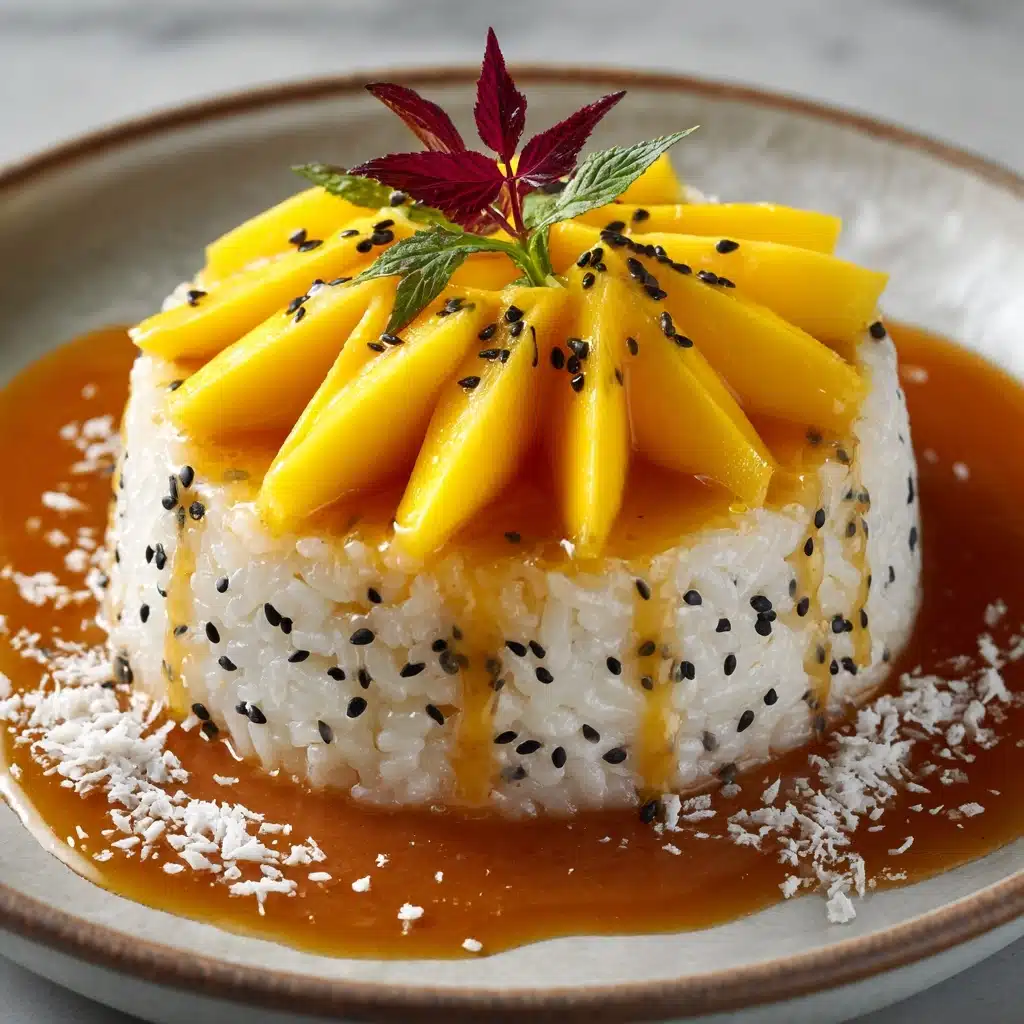
Garnishes
The right toppings elevate Mango Sticky Rice from a simple dessert to a restaurant-style showstopper. Toasted sesame seeds or crispy mung beans are my favorites for their subtle crunch and nutty undertone, but a little drizzle of extra coconut cream on top never hurts. For a splash of color, try edible flowers or a few mint leaves—you eat with your eyes first!
Side Dishes
If you’re planning a full Thai spread, Mango Sticky Rice pairs beautifully with light, citrusy courses. Think fresh spring rolls, a zesty papaya salad, or even a cooling lemongrass tea. Its creamy sweetness provides a soothing contrast to spicy, savory main dishes, making it the perfect happy ending to any meal.
Creative Ways to Present
For a party, make mini Mango Sticky Rice cups using small ramekins or even clear tumblers, layering rice, mango, and coconut sauce. You can shape the sticky rice with a ring mold for a stunning effect, or even skewer mango pieces with a ball of rice for fun, kid-friendly “dessert kebabs.” Mango Sticky Rice is as adaptable as it is delicious—don’t be afraid to experiment!
Make Ahead and Storage
Storing Leftovers
If you happen to have leftovers, keep your Mango Sticky Rice and mango slices separate in airtight containers in the refrigerator. The rice may become firmer as it chills, but it will still be delicious for a day or two. Be sure to store the coconut sauce separately so you can rewarm it without overheating the fruit.
Freezing
While fresh is always best, you can freeze cooked sticky rice for up to a month. Cool it completely, wrap tightly, and store it in a freezer-safe bag. Thaw overnight in the fridge. Avoid freezing mangoes since they tend to lose their luscious texture and can get watery once defrosted.
Reheating
To reheat sticky rice, sprinkle it with a little water and microwave covered in 30-second bursts or gently steam it again. Warm the coconut sauce separately until it’s pourable, then assemble with fresh mango slices for a nearly-as-good-as-new experience.
FAQs
Can I use regular rice if I don’t have glutinous rice?
For true Mango Sticky Rice, glutinous rice (sometimes labeled as sweet rice or Thai sticky rice) is a must—it delivers the signature chewy texture that makes this dessert special. Regular rice won’t absorb coconut milk in the same way or hold its shape, so it’s worth seeking out the real thing at Asian markets or online.
What type of mango works best for Mango Sticky Rice?
Go for ripe, fragrant varieties with a smooth texture and rich sweetness. Thai Nam Dok Mai or Ataulfo mangoes are ideal, but any ripe, yellow-fleshed mango will work beautifully. Just avoid fibrous or under-ripe mangoes, which can spoil the creamy dreaminess of the dessert.
Is Mango Sticky Rice vegan and gluten-free?
Yes! This classic treat is naturally vegan and gluten-free, making it a wonderful option for guests with dietary preferences or sensitivities. Just double-check your coconut milk and toppings to stay on the safe side.
How far in advance can I prepare Mango Sticky Rice?
You can soak the rice a day ahead, and even cook the coconut sauce early to save time. Assemble everything just before serving for the best flavor and texture—the rice tastes best when slightly warm and freshly sauced!
Can I make Mango Sticky Rice less sweet?
Absolutely. If you prefer less sweetness, feel free to reduce the sugar in the coconut sauce to suit your taste. The beauty of homemade Mango Sticky Rice is how effortlessly you can adjust it to your family’s preference.
Final Thoughts
I can’t recommend Mango Sticky Rice highly enough—it’s a joy to make and an even bigger delight to share. Whether you’re new to Thai desserts or a longtime fan, this recipe delivers tropical comfort and simple happiness in every spoonful. Give it a try, and don’t be surprised if it instantly becomes your go-to treat for special nights or just because!
Print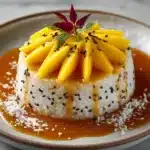
Mango Sticky Rice Recipe
- Total Time: 1 hour 35 minutes
- Yield: 4 servings 1x
- Diet: Vegan, Gluten-Free
Description
Indulge in the tropical flavors of Thailand with this delicious Mango Sticky Rice. Sweet and creamy coconut sticky rice is paired with ripe mango slices for a dessert that will transport you to paradise.
Ingredients
Sticky Rice:
- 1 cup glutinous (sticky) rice
- 1 1/2 cups water
Coconut Sauce:
- 1 1/2 cups canned coconut milk (full fat)
- 1/2 cup granulated sugar
- 1/4 teaspoon salt
Additional:
- 2 ripe mangoes, peeled and sliced
- 1 tablespoon toasted sesame seeds or mung beans (optional for garnish)
Instructions
- Rinse and Soak Rice: Rinse the sticky rice several times until the water runs clear. Soak the rice in water for at least 1 hour (or overnight for best results), then drain.
- Cook Rice: In a saucepan or steamer, combine the soaked rice with 1 1/2 cups water. Steam or cook over low heat, covered, for 20–25 minutes or until the rice is tender and sticky.
- Prepare Coconut Sauce: In another saucepan, combine the coconut milk, sugar, and salt. Heat over medium (do not boil), stirring until the sugar dissolves completely. Remove from heat.
- Combine and Serve: Once the sticky rice is done, transfer it to a large bowl and gently stir in 1 cup of the warm coconut sauce. Let it sit for 15–20 minutes to absorb the liquid. To serve, spoon the sticky rice onto plates and top with mango slices. Drizzle with the remaining coconut sauce and sprinkle with toasted sesame seeds or mung beans, if using. Serve warm or at room temperature.
Notes
- Use Thai sweet rice or glutinous rice for authentic texture.
- For extra creaminess, reserve a few tablespoons of thick coconut cream from the top of the can for drizzling.
- Prep Time: 10 minutes (plus 1 hour soaking time)
- Cook Time: 25 minutes
- Category: Dessert
- Method: Stovetop
- Cuisine: Thai
Nutrition
- Serving Size: 1 cup
- Calories: 370
- Sugar: 22g
- Sodium: 130mg
- Fat: 15g
- Saturated Fat: 13g
- Unsaturated Fat: 2g
- Trans Fat: 0g
- Carbohydrates: 55g
- Fiber: 2g
- Protein: 4g
- Cholesterol: 0mg
